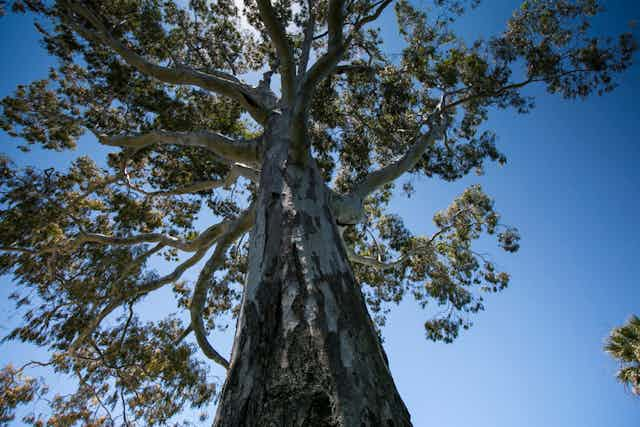For thousands of years, trees and humans have maintained an intimate connection. It’s therefore not surprising that many tree species were moved around the world, following the footprints of human civilisation.
Globally, however, more tree species are becoming invasive, with detrimental ecological and socio-economic impacts. Understanding their invasion history and ecology is essential to developing effective management approaches.
Vast areas of Africa’s southernmost country are characterised by invading tree species. These include wattles, pines, mesquite and eucalyptus. Such invasions are especially worrying in drought stricken South Africa because most invasive trees use more water than other plant groups.
Among the invasive trees with the most severe effects, particularly when it comes to water consumption, are several Eucalyptus species. More than 200 Australian eucalypt species have been introduced to South Africa since the 1800s, most for forestry growth trials and cultivation. They are fast growing and useful – providing timber, paper, poles, firewood, shelter, ornamental value, and nectar and pollen for bees.
Some species, however, escaped cultivation and started to establish populations outside plantations. There are six eucalypt species listed as invasive by the country’s environmental legislation: forest red gum, karri, river red gum, saligna gum, spider gum, and sugar gum. Their listing means they should be controlled or retained, depending on the habitat in which they occur.
Invasive eucalypts account for 16% of the 1,444 million cubic metres of water resources that South Africa loses every year due to invasive plants.
Of the listed eucalyptus species, river red gum (Eucalyptus camaldulensis Dehnh) is considered to be the most widespread and aggressive. It has the largest native range among Australia’s more than 700 native eucalyptus species and is also one of the most widely planted around the globe.
But there’s a lot that isn’t known about the river red gum in South Africa. To bridge the knowledge gaps, we compiled a comprehensive species profile on river red gum. This involved a comprehensive literature review as well as consulting experts such as foresters, researchers and invasive species managers.
We gathered information on the trees’ introduction and planting history, current distribution and value for commercial forestry. Also, aspects about it as an invader, associated pests and pathogens, people’s perception of the species and conflicts of interest were considered.
We also collected information on management and restoration options, knowledge gaps and further research needs.
The outcome of all these endeavours was recently published in an extensive dossier on river red gum.
With this review, we were able to define the knowns and unknowns on this iconic tree to pave the way towards a national management strategy. Besides area-specific control measures, such a strategy should also consider perceptions and needs of different stakeholder groups to minimise conflicts of interest.
The eucalyptus
River red gum became popular after its introduction to South Africa around 1870. This was because it was useful for a variety of products and services like wood, shade and shelter.
Nowadays, river red gum is a major problem along many river courses, especially in the Western Cape. Over the past two decades the government has spent more than R400 million trying to clear the species.
However, little is known about the species’ history in South Africa. Nor is very much known about its exact abundance, the specific environmental conditions which trigger its invasion, and how associated pests and diseases might influence its future success as invader. This lack of knowledge clearly hampers the development of effective and sustainable management options.
Our work shows that river red gum is a poster child example of a conflict-generating species in the country. This is because it brings benefits (such as nectar and pollen for bees, habitat for raptors, wood), but can also have huge negative effects (such as alteration of river structure, impact on local biodiversity).
But management approaches have mostly followed a “one-fits-all” philosophy and proved in several cases inefficient. Most approaches in invaded riparian areas entail the removal of all woody invasive plants with the assumption that the ecosystem will recover by itself.
Also, we found that the current legislative listing of river red gum is very complicated and confusing. This makes the enforcement of the listing for this species difficult and has also the potential to fuel conflicts of interest.
New approach needed
Our research shows that the complexity that evolves around river red gum in South Africa needs to be addressed in future management options. Specifically, interventions must be regulated and coordinated at national level as well as regional and landscape scales.
And, to be effective, stakeholders (such as beekeepers and landowners) need to be encouraged to get involved to solve conflicts of interests.
We also suggest options for improved management approaches that use principles of vegetation succession – that is where trees are replaced over time rather than simply cleared away. This is a much more sustainable way of approaching the problem, particularly where the restoration of the natural riparian forest vegetation is the end goal. Although this approach takes longer than complete clearing, it’s more sustainable because it allows for the development of income-generating entrepreneurship and can help reduce conflicts of interest.
We also recommended a simplification of the legislative listing of river red gum.
Our work shows how important it is to move away from demonising certain species by considering not only what impacts they have, but also their benefits and geographic dynamics. Our findings also show that it’s important to engage with different stakeholder groups to develop meaningful management goals.
Overall, our review provides a blueprint for the types of information needed for developing management strategies for non-native tree species in different parts of the world.

